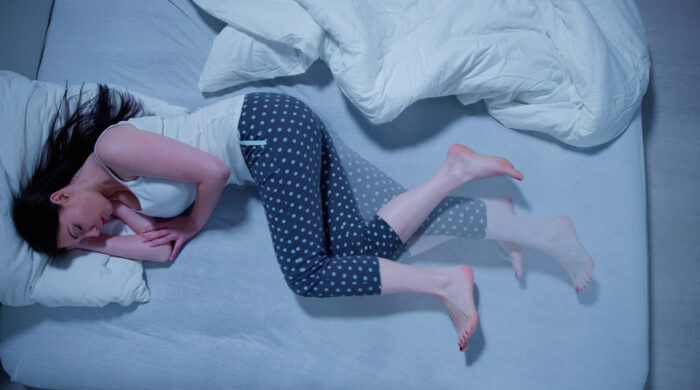As its name implies, Restless Legs Syndrome causes unpleasant or uncomfortable sensations followed by an irresistible impulse to move the legs.
Frequent nighttime symptoms can lead to sleep loss and fatigue, negatively impacting one’s energy level, daily activities, and ultimately their health.
An experienced Sleep Medicine specialist can diagnose and treat people who suffer from Restless Legs Syndrome (RLS). Read on to learn more about RLS’s symptoms, its impact on sleep, its causes and connection to other health issues, and how to seek a diagnosis and treatment.
Symptoms of RLS
Symptoms of RLS include an aching, throbbing, pulling, itching, crawling, or creeping feeling in the legs with an unavoidable urge to move the limbs. These sensations may occur when sleeping, resting or sitting for long periods, such as in a car or airplane.
RLS symptoms may vary from day to day, in severity and frequency, and from person to person. In severe cases of RLS, the symptoms occur more than twice a week.
Individuals with RLS symptoms should seek an evaluation with a Sleep Medicine specialist to determine the best path to finding relief.
Restless Legs Syndrome Interrupts Sleep
During sleep, many individuals with RLS have involuntary or jerking leg movements called periodic limb movements. These movements may disrupt sleep and over time contribute to sleep deprivation, which can negatively impact one’s health.
Periodic limb movements may also occur during the day, but they’re harder to notice then, because most people naturally move around after their legs start to bother them.
RLS usually affects the legs. But it can also cause unpleasant feelings in the arms, torso, or even a phantom limb.
Like any condition that impacts quality of sleep, RLS can lead to daytime sleepiness, anxiety and depression, confusion, and difficulty thinking clearly.
RLS and periodic limb movements may also disturb the sleep of a bed partner. This could cause fatigue for both people and can strain the relationship.
Causes of RLS
There are several different causes of RLS:
1. Iron Deficiency
Although Restless Legs Syndrome is quite common, many people with the condition are unaware that iron deficiency is a major cause.
Dr. Tomasz Ziedalski, WWMG Sleep Medicine specialist, explains that even if someone’s blood iron level is in the normal range, iron stores in the brain and nervous system can still be low, causing iron deficiency.
“To check, we measure ferritin, a blood protein that stores iron. If the ferritin level is lower than normal, the body’s iron stores are low, and the patient has iron deficiency. If ferritin is below a certain value, we start iron supplementation.”
2. Disruption of Dopamine in the Brain
RLS also may be related to a dysfunction in a part of the brain that controls movement. The basal ganglia uses the brain chemical dopamine to produce smooth, purposeful muscle activity and movement. Disruption of dopamine levels in the brain can result in involuntary movements.
Individuals living with Parkinson’s disease have an increased risk of developing RLS.
3. Other Health Conditions
RLS appears to be linked to the following health conditions and underlying factors:
- Sleep deprivation and conditions such as sleep apnea
- Use of alcohol, nicotine, and caffeine
- Neuropathy (nerve damage)
- End-stage renal disease and hemodialysis
- Pregnancy or hormonal changes, especially in the last trimester (in most cases, symptoms usually disappear within four weeks after delivery).
4. Family History of RLS
RLS often runs in families, and specific gene variants have been identified with the condition.
Occurrence of RLS in the U.S. Population
According to the National Institutes of Health (NIH), it is estimated that up to seven to 10 percent of the U.S. population may have RLS. The condition occurs in both males and females, although females are more likely to have it.
RLS generally is a lifelong condition. Many people who are severely affected are middle-aged or older. Symptoms typically become more frequent and last longer as a person ages.
Diagnosis and Treatment of RLS
RLS can begin at any age, although its diagnosis and treatment in children is often challenging. Children may not be able to provide a good description of the symptoms, and some childhood conditions can mimic RLS.
Treatment for RLS is based on the patient’s assortment and severity of symptoms.
When evaluating patients who have symptoms of RLS, Dr. Ziedalski begins with a detailed medical history and a review of what medications the patient is taking. Some antidepressants, for example, can worsen symptoms.
Dr. Ziedalski explains, “Because RLS can be linked to other aspects of the person’s health, we look at it holistically to figure out the reason. For treatment, we always start with non-medical management options such as exercise, avoidance of alcohol and/or caffeine, water therapy, or massage.”
In addition, there are prescription medications that can help, “but we use them as a last option. Some people can develop tolerance to some of these drugs, requiring higher and higher doses, which is best avoided.”
Getting regular exercise and enough sleep may be enough to lessen mild symptoms.
The National Institutes of Health recommends the following lifestyle changes for those seeking relief for mild-to-moderate RLS symptoms:
- Avoid or decrease the use of alcohol, nicotine, and caffeine
- Change or maintain a regular sleep pattern
- Try moderate, regular exercise
- Massage the legs or take a warm bath
- Apply a heating pad or ice pack
- Use foot wraps specially designed for people with RLS, or vibration pads to the back of the legs
- Do aerobic and leg-stretching exercises of moderate intensity.
Where to Seek Help for RLS
If you’re experiencing the symptoms of Restless Legs Syndrome and need relief, seek an evaluation with a WWMG Sleep Medicine specialist. They’ll partner with you to determine the best course of treatment, so you can reduce any negative impacts on your health, and get back to sleeping through the night.
